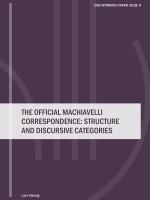A lesson in discursive discipline in times of stories and performative writing
It is a well-established historical fact that the, still valid, model for diplomacy, the permanent resident bilateral representation, is a creation of the Italian Renaissance.
Comparing the official Machiavelli letters, instructions and government papers with other contemporaneous diplomatic correspondences, this study takes a step further. It confronts these sources with the conventional distribution of discursive layers in the chancellery product: information, interpretation, analysis and operational matters.
Put to the test, the Machiavelli correspondence emerges as a particularly illustrative example of clear-cut practices, of discursive discipline. Overwhelmingly these discursive layers remain distinct in his dispatches. Moments of confusion and overlap are rare.
Beyond these findings, which also include an in-depth analysis of the Machiavelli technical language, the study puts invasive contemporary tendencies into perspective. Current policies of ‘values’, populism and individual posturing appeal to opinion and faith rather than to truth. Their secondary effects include expansion of propaganda, and disinformation - with their compulsory amalgamation of discursive layers. For foreign services, these developments entail risks materializing in a recourse to public diplomacy, to reporting commanded by leads, ultimately to performative writing – as during the wars of religion.
DIIS Experts


